
Its History, Legends and Lore / by Dorothy V. Corson


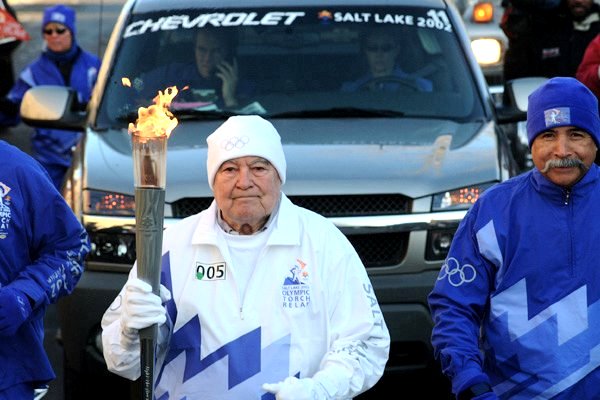
The first time I looked at this photograph, I saw in my mind’s eye, an iconic imagery of Father Hesburgh carrying the torch of the “Spirit of Notre Dame” into the new millennium. What a splendid example for others to follow. And what an inspiration he must have been, and always will be, to all those lined up along the parade route, and to future generations of the Notre Dame family. He has become a legend in his own time. His uniqueness of spirit and lifelong achievements so embody the “Spirit of Notre Dame” -- that steadfast faith and hope in its heritage and its mission -- that it inspired me to research the history of this time-honored expression.
It was Father Edward Sorin, Founder of the University of Notre Dame, and his band of seven Brothers, who first displayed that pioneer spirit and fortitude that carved a future University out of a Midwestern wilderness. Sorin’s faith in Mary was unshakable. Throughout countless trials and tribulations, epidemics, and numerous fires on campus, he remained steadfast in his faith and his vision, to build a University dedicated to Mary in the new world. After a disastrous fire that destroyed the Main Building in the spring of 1879, he exclaimed that he had dreamed too small a dream and he would build an even bigger and better building than the one destroyed. He set about doing it and it was done by the time the students returned in the fall.
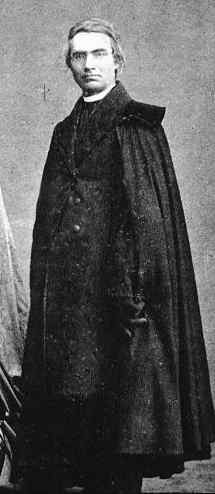 Many have followed in their courageous footsteps. Notre Dame’s priest chaplains associated with the Fighting Irish Brigade during the Civil War, Father Wm. Corby among them, also embodied that “Notre Dame Spirit,” as did countless Notre Dame students, alumni and chaplains on many a bloody battlefield since. Sorin’s example, his unconquerable spirit, continues to inspire those who have come after him. They have fulfilled his mission far beyond anything he could ever have envisioned.
Many have followed in their courageous footsteps. Notre Dame’s priest chaplains associated with the Fighting Irish Brigade during the Civil War, Father Wm. Corby among them, also embodied that “Notre Dame Spirit,” as did countless Notre Dame students, alumni and chaplains on many a bloody battlefield since. Sorin’s example, his unconquerable spirit, continues to inspire those who have come after him. They have fulfilled his mission far beyond anything he could ever have envisioned.
However, it was in the early days of football during the Rockne era -- when spirited football teams inspired by Rockne’s legendary leadership imparted that spirit to the student body -- that it began to evolve into a Notre Dame tradition passed on from generation to generation. Rockne was another larger than life influence on campus. He had that same kind of powerful spirit that exuded confidence. He imbued his young athletes with his faith in them and the ambition to succeed against all odds.
Not long after the first game and the first radio broadcast from the newly built Notre Dame Stadium, another event took place that put the spotlight on the University of Notre Dame. In the spring of 1931 Rockne was killed in a tragic plane crash. Shortly after his untimely death, an early talkie film dedicated to him, all but forgotten now, left its imprint on the movie-going public across the nation. The Notre Dame Alumnus published an article about it entitled, “How ‘The Spirit of Notre Dame’ Was Made: The Story Behind the Film which was made as a Memorial To The Late Knute K. Rockne.”
It explained how in 1930 permission was obtained from Knute Rockne to make a moving picture in which he was to play an actual role on the screen. Excerpts from the article describe the circumstances of that movie:
Naturally, the plans for the picture were all awry, but out of the pieces, Christy Walsh, Carl Laemmle, Jr., and the president of the University of Notre Dame [Fr. Charles O’Donnell], created something which was even more significant than the picture in which Rockne was to star. This something was a picture in which those who admired him most could create a memorial to the expert coach, the human athletic director, the peerless leader of men and the ideal of the football world. This something is ‘The Spirit of Notre Dame.’
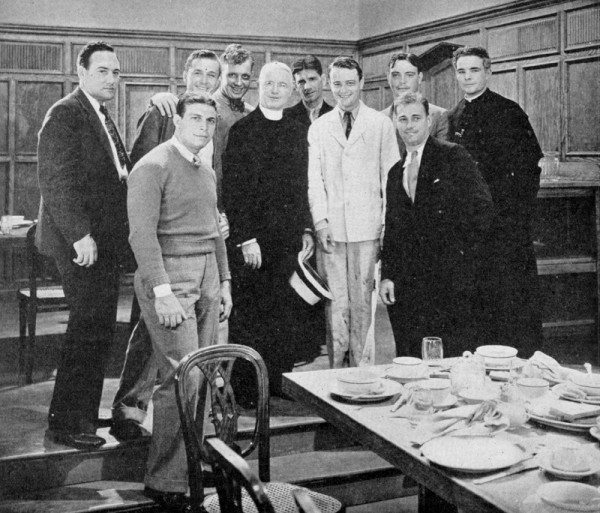
Great good fortune, devotion to their leader and the inspiration of a revered institution hovered over ‘The Spirit of Notre Dame.’ It is no wonder that it is a tremendously entertaining picture. It is no wonder that it has all the qualities of truth and actuality which will appeal to every one who has been to college.
The Hollywood Herald also recommends the picture and offers its own interpretation of the title of the film: “There is sound philosophy in the ‘Spirit of Notre Dame,’ it says. “It is the philosophy of keeping your eye on your goal and your mind on your work. It is the philosophy of fair play and more, the corner stone of success, team play.” And in true Sorin fashion, it is also never giving up on something -- or someone -- you believe in. No matter how rough the road, no matter how long it takes.
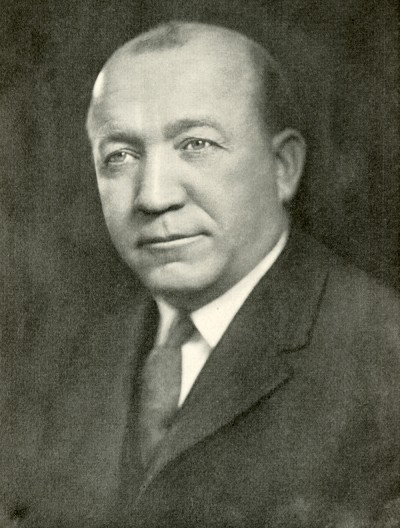
Rockne tried to see Fr. O’Donnell the day he left to justify his impending trip to Hollywood but the Notre Dame President was not available. Rockne’s words in a last letter he left on his desk unknowingly foretold the future. “The only thing is I thought perhaps there might be a chance to put out a picture that might be instructive and educational as regards Notre Dame in every sense of the word.” In essence, for the greater glory of Notre Dame. Many accolades followed the demise of the “Viking of Football.” Among them, this sentiment: “Death is not always unkind; tragedy and glory sometimes go hand in hand. Knute Rockne is not dead. His was a spirit that does not die. His address was Notre Dame but his home is every gridiron in America.”
The era of radio broadcasting that followed Rockne’s death was also a driving force in establishing the University’s name recognition and its rise to national prominence. Paul Gullifor in his book, The Fighting Irish on the Air, explains how “Notre Dame’s free open door policy, involving radio broadcasting of college sports, combined with the NCAA’s leniency, resulted in the largest radio audience for any college football team in the country.”
Win or lose, exemplifying the “Notre Dame Spirit” has become a Notre Dame tradition and a philosophy worth living up to, passed on in the Notre Dame family throughout the generations. One day at the University Archives I heard someone shout, “Stop everything! A nursing home is calling. They need the words to the ‘Notre Dame Victory March.’ A 100 year old Notre Dame alumnus is dying and he wants them to sing it to him.” The words were faxed to the nursing home by the archives and his last request was granted. He passed away on St. Patrick’s Day. It is stories like this one that have created a mystique about the University of Notre Dame, its alumni, and its campus, unequaled anywhere else.
The “Spirit of Notre Dame” has become synonymous with this uncanny ability Sorin had to triumph in the end. Similar fortuitous happenings were said to have occurred on campus during the filming of the movie, Rudy. A perfectly timed touchdown in the Notre Dame stadium caught by chance during the filming of the movie marked the beginning of similar strange events that kept up throughout the two and a half months of campus shooting. Rudy himself would later describe this atmosphere on campus as “a certain force, an energy that pulled everybody through the grueling, 85-hour-a-week schedule and allowed each person to perform on a level higher than usual. It came to be called the 'God loop.' It provided good luck when least expected. It was the spirit that made the impossible, possible.” I have experienced that kind of luck many times on campus in my search for answers.
Emerson called it: “That ineffable essence which we call spirit -- the sense of a presence, a spiritual or immaterial entity.” It hovers over the beauty of the lakes and the landscape, the Basilica and the Dome, but most especially, it seems to be a presence felt most strongly at the Grotto of Our Lady of Lourdes at Notre Dame. This peaceful oasis at the heart of the campus is filled with all the hopes and dreams of everyone who has been a part of that river of humanity that has flowed through the campus in the past more than 160 years. In spirit, they live again in the hearts and minds of future generations whenever anyone tells their story or says their name. The inspiration of their contributions to “The Spirit of Notre Dame: Its History, Legends and Lore” has been “the wind beneath my wings.” It has kept me going throughout my over ten years of research.
Notre Dame du Lac, Our Lady of the Lake, is the home of Mary to whom all the grounds and buildings are dedicated, to whom is given all the credit for the work done here. She is patroness of the university. In fulfilling her destiny, Mary became the ultimate symbol of unshakable faith. Those who have revered her through the ages have been uplifted and inspired by her faith. Mary imparted that same unshakable faith to Bernadette the little untutored peasant girl at Lourdes. And to Sorin, who envisioned a university in the wilderness of Indiana honoring Mary. We see it in Rockne and his winning football teams and in “Rudy” who found renewed faith and hope at Notre Dame’s Grotto to exemplify his own “Never Give Up” philosophy.
St. Bernadette saw a vision of Mary at the Lourdes Grotto in France, not once, but eighteen times. In spite of the harassment and ridicule she endured, her belief in the vision of Mary she saw at Lourdes never wavered. Bernadette was 35 years old when she died. Her example of fearless faith under pressure became an inspiration to a multitude of people throughout the world, regardless of their faith.
Sorin had that same dauntless faith. In so many ways, he became an instrument of Providence for the very reason that he was a man who just wouldn’t give up on what he believed to be his mission in life. And because he felt his dream was from and for Our Lady, he was willing to go where no man had gone before in fulfilling his mission. In that respect, the Notre Dame of today has proven -- he was a man of destiny. He embraced whatever life sent, without complaint and with supreme faith, always believing in life’s infinite possibilities. Through him and for him the “Spirit of Notre Dame, Our Lady” lives on. His life is proof that wherever our focus goes spirit and energy flows, whether it’s on the football field, in the classroom, or in our daily lives. It never dies, it just takes another form: it returns as inspiration.
The torch of “The Spirit of Notre Dame” has now been passed on to Father Monk Malloy, President of the University, and to all those who are destined to carry on its football heritage and its academic mission into this new millennium.
Thomas McAvoy, former Director of the University Archives was a dedicated historian and archivist who wrote several books on the history of Indiana. I took particular pleasure in reading everything he faithfully recorded about it. In doing so, I chanced upon a gem of thought penned by Father McAvoy that became not only a favorite quote but a “touchstone” during my research. It appeared as a single sentence in the midst of a paragraph in an essay he wrote [ca. 1925] called, “The Location of Old Fort St. Joseph,” which is preserved in Rare Books and Special Collections at the Hesburgh Library.
Father McAvoy gave no special significance to the words he had unwittingly coined, but to me they spoke volumes about the “Spirit of Notre Dame” I have come to know. I used his quote at the beginning of my historical journal of research and everything I have found since has shown that the history of the University of Notre Dame du Lac has more than lived up to his definition:
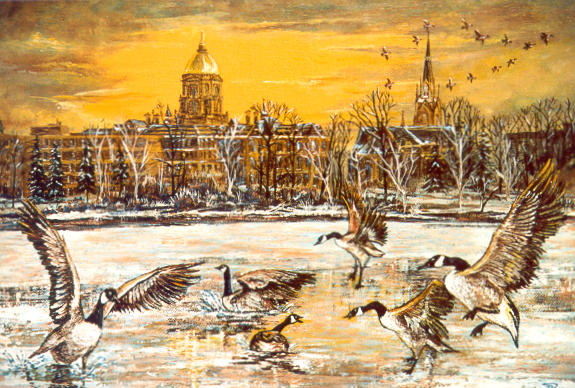
For those who would like to learn more about “The Spirit of Notre Dame: Its History, Legends & Lore” come join me on that “Trail of Memories . . . .”
Dorothy V. Corson
April 5, 2002